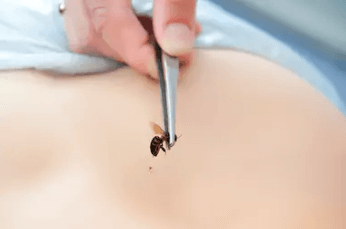Honey and the use of bees for medicinal purposes spans time and cultures. Ancient Egyptians, Greeks, and Chinese used bee venom as a medical treatment. Hippocrates who is considered the father of Western medicine prescribed bee venom for osteoarthritis.
Apitherapy, however, did not die with the ancients. Traditional Chinese Medicine, Ayurveda, and other alternative medical systems throughout the world still use apitherapy. While apitherapy has a lot of anecdotal evidence, it was short on research. However, recent studies suggest that bee venom may be useful for the treatment of Lyme disease and certain cancers.
The use of honey, bees, or any bee products (propolis, beeswax, venom, pollen) for medicinal purposes is called apitherapy. Using bee venom specifically is also referred to as herbal acupuncture, bee venom acupuncture, or apipuncture. Directly applying bees on the body and having them sting the patient has in large part been replaced with bee venom. Bee venom can also be taken orally.
Bee venom is said to contain at least 18 active compounds including enzymes, peptides, and biogenic amines. It’s some of these compounds that are showing promise for treating specific diseases.
Lyme Disease
Lyme disease is a bacterial infection that is the result of a bite from a nymphid (immature) deer tick. Ticks hang out in tall grasses and wooded areas. Once thought to be only a concern for those living in the Northeast, Lyme disease is spreading to other areas of the country including the West coast. Every year approximately 300,000 people in the U.S. are diagnosed with Lyme disease according to the Center for Disease Control and Prevention. Research suggests melittin, one of the peptides in bee venom, can inhibit the bacteria that causes Lyme disease.
Lyme disease is often hard to cure because many patients often have relapses once traditional treatments using antibiotics are stopped. While the reason for relapse is not known, one suggested reason is that the bacterium Borrelia burgdorferi that causes Lyme disease becomes antibiotic resistant. Researchers at the University of New Haven in West Haven, CT found that bee venom and melittin significantly affected B. burgdorferi more than antibiotics alone or a combination of venom and antibiotics.
Because Lyme disease can affect multiple areas of the body, bee venom is either used systematically or injected directly into key areas. For example, sore or tender areas in the muscles or joints may be injected directly. Also, acupuncture points, such as the gallbladder and bladder meridians, associated with Lyme disease symptom may be injected.
Standardized bee venom improves the efficacy because melittin strength can vary depending on the season, where the bees come from, and the type of pollen that bees gather. This is one reason using vials of bee venom is preferred over bee stings. Bee venom therapy may also be one of several treatments used to treat Lyme disease naturally.
Because allergic reactions are a possibility, bee venom therapy must only be administered by healthcare practitioner specialized in apitherapy, such as a naturopathic doctor, medical doctor, or experienced TCM practitioner.
Cancer
Researchers at Texas Tech University in Lubbock, Texas reviewed multiple clinical studies using apitherapy to treat cancer cells; the report showed some promising results. Several anti-carcinogenic compounds are found in honey (raw), pollen, and royal jelly. However, it’s melittin that is receiving the most attention especially in combination with the latest technology.
Melittin’s ability to kill cancer cells has been known for years. New research is focusing on the use of nano-vehicles to deliver melittin into the bloodstream to directly search for cancer cells and destroy them. Nano-vehicles are “machines” on a molecular (nanoparticle) scale. In medicine, nanoparticle DNA, polymers, and liposomes are a few of the types of delivery systems being investigated or used.
The review also showed that melittin inhibits the proliferation of specific cancer cells and prevents metastasis (cancer cell moving to other parts of the body). The report suggested that a combination of melittin and chemotherapy may be a possibility to reduce the effects of chemotherapy treatment. In addition, chrysin found in propolis, a bee glue made from bee saliva and beeswax, in combination with bee venom shows promise for treating breast cancer.
While more studies may be necessary, bee venom shows promise in treating cancer and Lyme disease. As mentioned earlier, due to the possibility of a severe allergic reaction, bee venom therapy must only be given under the strict supervision of an experienced and qualified medical professional. Always consult your doctor before considering any alternative treatment especially if you have a health condition.
This information is for educational purposes only. It’s not intended to diagnose, treat, or recommend any treatment, medicine, or therapy.
References:
- Abd-Elrehim Abd-elaziz Badria, Farid, et al. Evaluate the cytotoxic activity of honey propolis, and bee venom from different localities in Egypt against liver, breast, and colorectal cancer (February 4, 2017). Retrieved from https://www.ejmanager.com/mnstemps
- About Lyme Disease. Retrieved from https://www.lymedisease.org/lyme-basics/lyme-disease/about-lyme
- Buhner, Stephen Harrod. The Use of Apis and Bi-EDTA in the Treatment of Lyme Disease (2005). Retrieved from https://web.archive.org/web
- Butler, Christopher C. Antimicrobial Activity of Bee Venom and Melittin against Borrelia burgdorferi Socarras, Kayla, et al. Retrieved from http://www.mdpi.com/2079-6382/6/4/31/htm
- Klinghardt, Dietrich K., M.D., Ph.D. The Treatment of Lyme Disease with Bee Venom. Retrieved from http://www.klinghardtacademy.com/Protocols/The-Treatment-of-Lyme-Disease-with-Bee-Venom.html
- Netterwald, James. Nano-vehicles for Cancer Drugs (May 20, 2013). Retrieved from https://www.the-scientist.com/daily-news/nano-vehicles-for-cancer-drugs-39302.
- Tacon, Anna. Melittin and cancer (November 2, 2016). Retrieved from https://www.ejmanager.com/mnstemps/165/165-1471122996.pdf?t=1533562759.
- Tekeoglu, Ibrahim, et al. Bee venom apipuncture; a successful therapy for myofascial pain. A case based review (July 02, 2016). Retrieved from https://www.ejmanager.com/mnstemps
- Washington, Glynn. Venom (August 28, 2015). Retrieved from https://www.npr.org/2015/08/28/435501343/venom.
- Wasp and Bee Venom. Retrieved from https://www.drugs.com/pro/wasp-and-bee-venom.html.
- Ayurvedic Benefits of Honey (August 29, 2010). Retrieved from https://www.ayurveddoctor.com/ayurvedic-benefits-of-honey.html.
- Cheers! Eight ancient drinks uncorked by science. Retrieved from http://www.nbcnews.com/id/
- Honey In The Pyramids (November 23, 2015). Retrieved from https://www.nationalgeographic.com.au/history/honey-in-the-pyramids
- Kitchen Pharmacy: Healing Honey. Retrieved from https://www.tcmworld.org/kitchen-pharmacy-healing-honey
- Molan, Peter, Dr. Manuka Honey As Medicine (September 30, 3014). Retrieved from http://www.publichealthalert.org/manuka-honey-as-medicine.html

